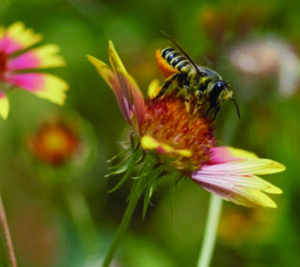By Debbie Roland and
Emmy Ulmschneider
Master Gardeners
Most of us are familiar with the European honeybee which was brought by colonists to North America almost 400 years ago. Not many of us know that we have roughly 4,000 species of native bees in the United States and Canada and we depend upon them for the ecosystem services they provide. Together, honeybees and native bees provide $10 to $20 Billion/year in agricultural value to the United States. Native bees are also effective pollinators of native plants, so the survival of native plants is linked to the survival of their pollinator.
So, who are our native bees? Texas has roughly 600 species of bees and they come in an amazing variety of sizes, shapes, colors, lifestyles and behaviors. Unlike the social European honeybee, most of our native bees are solitary nesters in the ground or in cavities such as hollow stems or tunnels. Bumble bees are truly social, they have a hive, but the colony is annual.

Bees are furry: They have hairs on their legs to collect pollen. There are also flies that mimic bees. Flies have two wings so they can usually be distinguished by their short antennae and two rather than four wings.
We can all provide habitat for bees. Native bees need a place that provides food, water, and shelter. Plant Texas native plants that bloom at different times of the year to provide food year-round. Bees are attracted to large groups of flowers so plant five (or more) plants together. Chose flower colors of white, yellow, or blue, and shapes that are shallow or tubular. Include native perennials such as Greg’s mistflower, lantana, asters, and goldenrods. Annual or short-lived perennials such as bluebonnets, larkspur, coreopsis, gaillardia, and sunflowers will also attract pollinators.
Bees need shelter. Leave brush piles in your yard and be slow to take down your garden. Cut large hollow stems like sunflowers to about a foot and leave them for native bees to nest in. Ground nesting bees look for bare soil; land that has not been tilled.
When providing water make sure that there is a very shallow option that bees can use.
Lastly, check out these references.
Mader, E. et al. 2011. Attracting Native Pollinators. Protecting America’s Bees and Butterflies. Storey Pub. North Adams, MA.
Pollinator Partnership: www.pollinator.org. Planting guides by zip code, pollinator syndrome chart and more.
Wilson, J.S. and O.M. Carril. 2016. A guide to North America’s Bees: The Bees in your Backyard. Princeton University Press. Princeton, N.J.
Xerces Society: www.xerces.org
For more information, call the AgriLife office at 498-4071 in Odessa or at 686-4700 in Midland or visit aggie-horticulture.tamu.edu or westtexasgardening.org.




